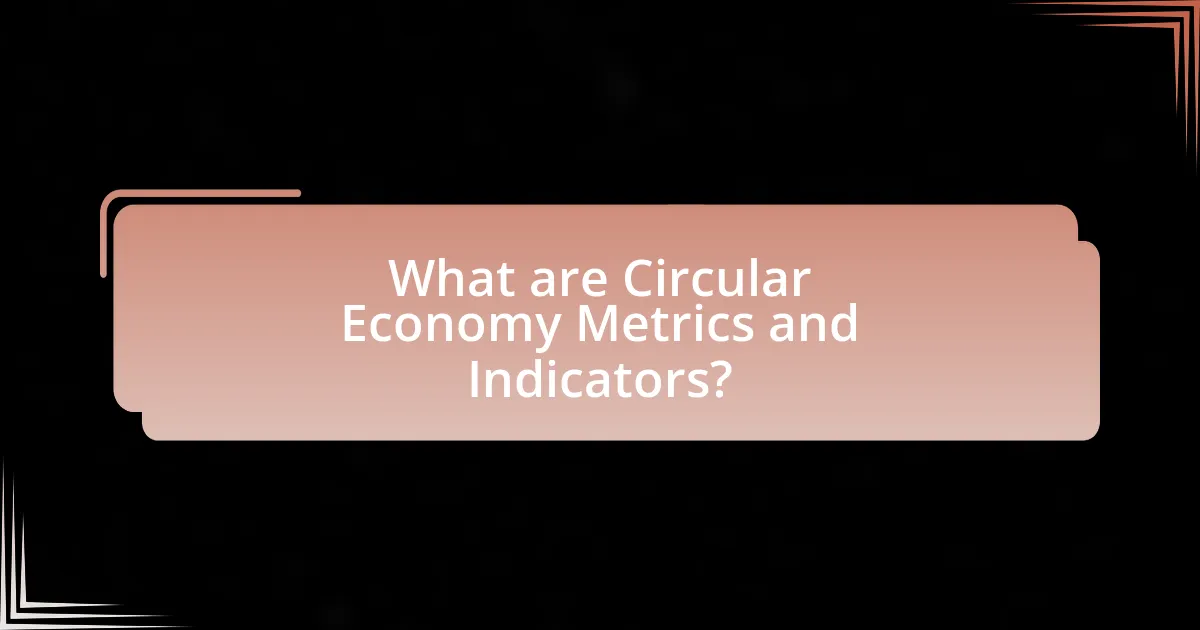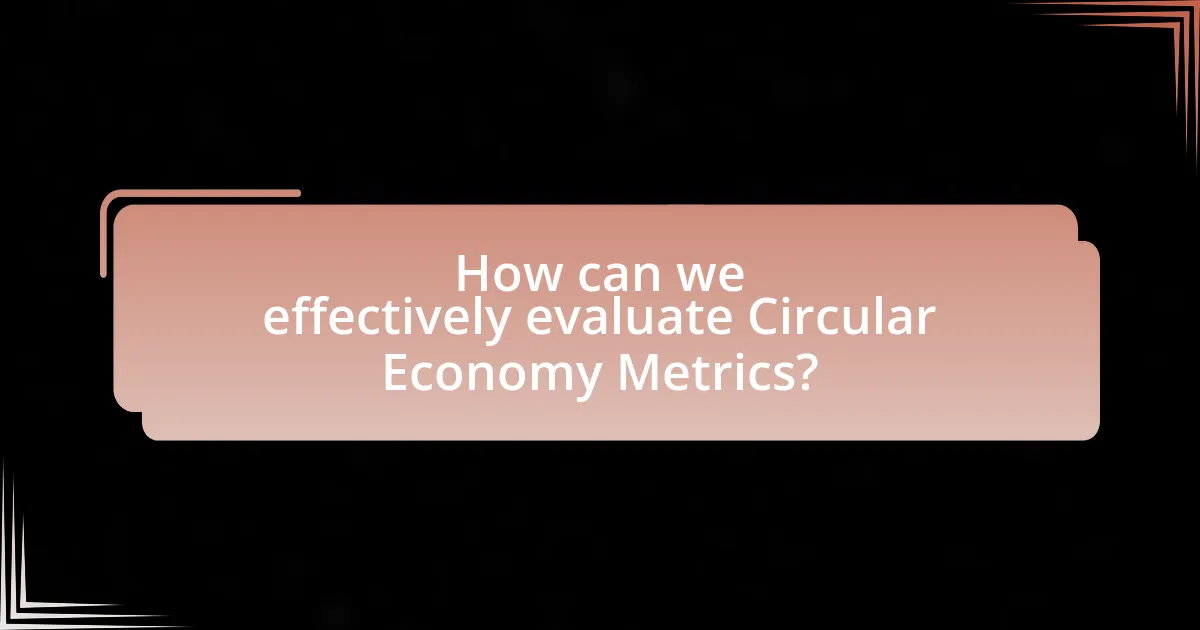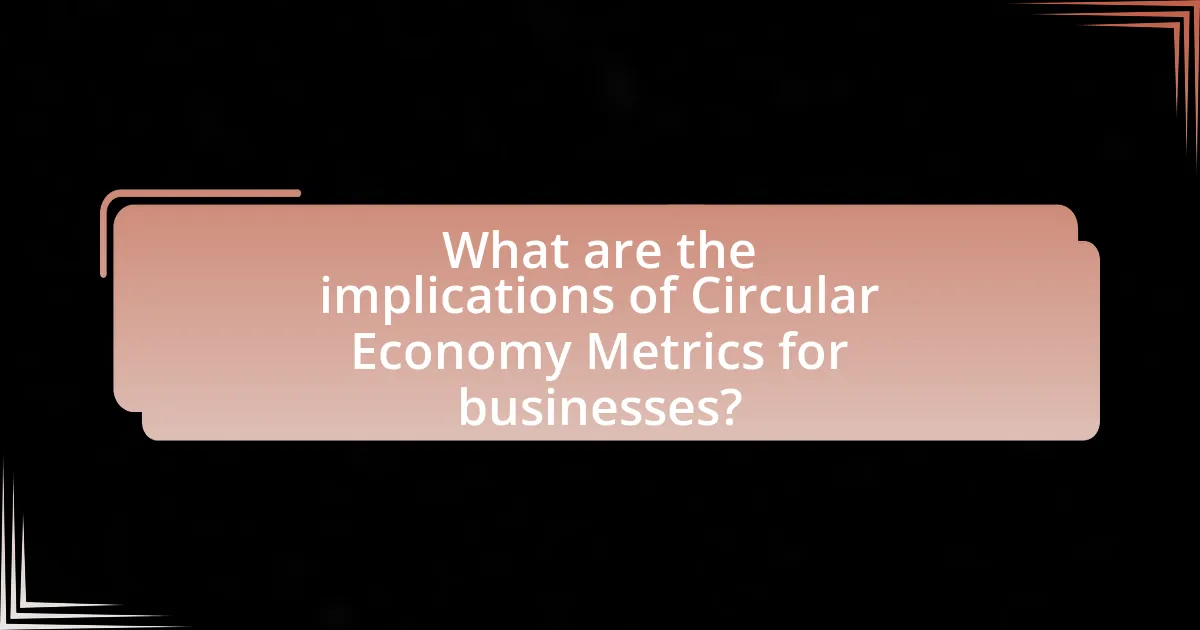Circular Economy Metrics and Indicators are essential tools for assessing the effectiveness of circular economy practices, focusing on resource efficiency, waste reduction, and sustainability. This article explores the definition and types of metrics used in circular economy evaluations, highlighting their differences from traditional economic metrics and their importance in measuring success. It discusses the challenges in evaluating these metrics, including data quality and metric selection pitfalls, while also outlining methodologies and best practices for effective evaluation. Additionally, the article examines the implications of these metrics for businesses, including their influence on strategy, potential financial benefits, and the role of technology in enhancing metric evaluation.

What are Circular Economy Metrics and Indicators?
Circular Economy Metrics and Indicators are quantitative and qualitative measures used to assess the performance and effectiveness of circular economy practices. These metrics evaluate resource efficiency, waste reduction, and the overall sustainability of economic activities, providing insights into how well materials are reused, recycled, or repurposed. For instance, metrics such as material circularity indicators, recycling rates, and life cycle assessments are commonly employed to gauge progress towards circularity. The European Commission has developed a Circular Economy Monitoring Framework, which includes specific indicators to track the transition towards a circular economy, demonstrating the importance of these metrics in policy-making and business strategies.
How do we define metrics in the context of a circular economy?
Metrics in the context of a circular economy are defined as quantifiable measures that assess the performance and effectiveness of circular practices in resource management and sustainability. These metrics evaluate aspects such as material recovery rates, waste reduction, and the lifecycle impacts of products, providing insights into how well a system minimizes waste and maximizes resource efficiency. For instance, the Ellen MacArthur Foundation emphasizes metrics like the circularity indicator, which quantifies the extent to which a product or system is circular, thus validating the importance of these metrics in driving circular economy initiatives.
What types of metrics are commonly used in circular economy evaluations?
Commonly used metrics in circular economy evaluations include resource efficiency, waste reduction, and lifecycle assessment. Resource efficiency metrics measure the amount of resources utilized in production processes, indicating how effectively materials are used. Waste reduction metrics track the decrease in waste generated throughout the lifecycle of products, reflecting improvements in sustainability practices. Lifecycle assessment evaluates the environmental impacts of a product from raw material extraction to disposal, providing a comprehensive view of its ecological footprint. These metrics are essential for assessing the effectiveness of circular economy initiatives and guiding decision-making towards sustainable practices.
How do these metrics differ from traditional economic metrics?
Circular economy metrics differ from traditional economic metrics primarily in their focus on sustainability and resource efficiency rather than solely on financial performance. Traditional economic metrics, such as GDP, emphasize monetary transactions and growth, often neglecting environmental impacts and resource depletion. In contrast, circular economy metrics assess the lifecycle of products, waste reduction, and the regeneration of natural systems, reflecting a holistic view of economic activity that prioritizes ecological balance. For example, metrics like material circularity indicators quantify how much material is reused or recycled, providing insights into sustainability that traditional metrics do not capture. This shift towards sustainability is supported by research indicating that integrating circular economy principles can lead to significant reductions in resource consumption and environmental impact, aligning economic activities with ecological health.
Why are indicators important for measuring success in a circular economy?
Indicators are crucial for measuring success in a circular economy because they provide quantifiable metrics that assess the effectiveness of resource use and waste reduction. These indicators enable stakeholders to track progress towards sustainability goals, such as minimizing landfill waste and maximizing resource recovery. For instance, the Ellen MacArthur Foundation emphasizes the importance of metrics like material circularity and waste diversion rates, which help organizations evaluate their performance and identify areas for improvement. By utilizing these indicators, businesses can make informed decisions that align with circular economy principles, ultimately leading to enhanced environmental and economic outcomes.
What role do indicators play in assessing circular economy performance?
Indicators play a crucial role in assessing circular economy performance by providing measurable data that reflects the effectiveness of circular practices. These indicators, such as material recovery rates, waste diversion percentages, and resource efficiency metrics, enable organizations to evaluate their progress towards sustainability goals. For instance, a study by the Ellen MacArthur Foundation highlights that using specific indicators can help businesses identify areas for improvement, track resource flows, and optimize processes, ultimately leading to enhanced circularity.
How can indicators influence decision-making in businesses?
Indicators can significantly influence decision-making in businesses by providing measurable data that informs strategic choices. For instance, key performance indicators (KPIs) related to sustainability can guide companies in assessing their environmental impact and operational efficiency. Research shows that businesses utilizing sustainability indicators can improve resource efficiency by up to 30%, leading to cost savings and enhanced competitiveness. By analyzing these indicators, companies can make informed decisions that align with their sustainability goals, ultimately driving long-term success in a circular economy framework.
What challenges exist in evaluating circular economy metrics?
Evaluating circular economy metrics faces several challenges, primarily due to the complexity and variability of circular economy practices. One significant challenge is the lack of standardized metrics, which leads to inconsistencies in measurement and reporting across different sectors and regions. For instance, the Ellen MacArthur Foundation highlights that varying definitions of circularity can result in divergent interpretations of what constitutes success in circular practices. Additionally, data availability and quality pose obstacles; many organizations struggle to collect reliable data on resource flows and waste management, which are essential for accurate metric evaluation. Furthermore, the dynamic nature of circular economy initiatives complicates long-term assessments, as benefits may not be immediately observable and can vary over time. These factors collectively hinder the effective evaluation of circular economy metrics, making it difficult to gauge progress and inform policy decisions.
What are the common pitfalls in metric selection?
Common pitfalls in metric selection include a lack of alignment with strategic goals, over-reliance on easily quantifiable metrics, and neglecting the context of the metrics. When metrics do not align with the organization’s objectives, they fail to provide meaningful insights, leading to misguided decisions. Over-reliance on easily quantifiable metrics can result in overlooking qualitative factors that are crucial for a comprehensive evaluation. Additionally, neglecting the context can lead to misinterpretation of data, as metrics may not accurately reflect the complexities of the circular economy. These pitfalls can hinder effective evaluation and implementation of circular economy initiatives.
How can data quality impact the evaluation of circular economy success?
Data quality significantly impacts the evaluation of circular economy success by influencing the accuracy and reliability of metrics used to assess performance. High-quality data ensures that indicators such as resource efficiency, waste reduction, and product lifecycle impacts are measured correctly, leading to informed decision-making. For instance, a study by Kirchgeorg et al. (2020) in the Journal of Cleaner Production highlights that poor data quality can lead to misleading conclusions about the effectiveness of circular practices, ultimately hindering progress towards sustainability goals. Therefore, robust data collection and management practices are essential for accurately evaluating the success of circular economy initiatives.

How can we effectively evaluate Circular Economy Metrics?
To effectively evaluate Circular Economy Metrics, organizations should implement a comprehensive framework that includes quantitative and qualitative assessments of resource efficiency, waste reduction, and lifecycle impacts. This evaluation can be supported by established metrics such as material flow analysis, carbon footprint calculations, and circularity indicators, which provide measurable data on the effectiveness of circular practices. For instance, a study by the Ellen MacArthur Foundation highlights that companies adopting circular economy principles can reduce resource consumption by up to 70%, demonstrating the tangible benefits of these metrics.
What methodologies are available for evaluating these metrics?
Various methodologies are available for evaluating circular economy metrics, including life cycle assessment (LCA), material flow analysis (MFA), and sustainability assessment frameworks. Life cycle assessment quantitatively evaluates environmental impacts across a product’s life cycle, providing a comprehensive view of resource use and emissions. Material flow analysis tracks the flow of materials through a system, helping to identify inefficiencies and areas for improvement. Sustainability assessment frameworks, such as the Global Reporting Initiative (GRI) and the Sustainability Accounting Standards Board (SASB), offer structured approaches to measure and report on sustainability performance, ensuring alignment with broader sustainability goals. These methodologies are validated by their widespread application in academic research and industry practices, demonstrating their effectiveness in assessing circular economy initiatives.
How do qualitative and quantitative methods differ in evaluation?
Qualitative and quantitative methods differ in evaluation primarily in their approach to data collection and analysis. Qualitative methods focus on understanding underlying reasons, motivations, and experiences through non-numerical data, such as interviews and observations, which provide in-depth insights into participants’ perspectives. In contrast, quantitative methods emphasize numerical data and statistical analysis, allowing for the measurement of variables and the identification of patterns through surveys and experiments. For example, a study evaluating circular economy metrics might use qualitative interviews to explore stakeholder perceptions of sustainability practices, while employing quantitative surveys to measure the frequency of those practices across a larger population. This distinction highlights how qualitative methods provide context and depth, whereas quantitative methods offer breadth and generalizability in evaluation.
What frameworks can be applied to assess circular economy metrics?
Several frameworks can be applied to assess circular economy metrics, including the Circular Economy Indicator System (CEIS), the Ellen MacArthur Foundation’s Circular Economy Framework, and the Global Reporting Initiative (GRI) Standards. The CEIS provides a comprehensive set of indicators that measure the performance of circular economy practices across various sectors. The Ellen MacArthur Foundation’s framework emphasizes the importance of designing for longevity, resource efficiency, and system-wide thinking. The GRI Standards offer guidelines for sustainability reporting, including metrics relevant to circular economy principles. These frameworks collectively enable organizations to evaluate their circular economy initiatives effectively and track progress towards sustainability goals.
What best practices should be followed in metric evaluation?
Best practices in metric evaluation include ensuring clarity, relevance, and consistency in the metrics used. Clarity involves defining metrics in understandable terms, which facilitates effective communication among stakeholders. Relevance ensures that the metrics align with the goals of the circular economy, such as resource efficiency and waste reduction. Consistency requires the application of the same metrics over time to allow for comparability and trend analysis. For instance, the Ellen MacArthur Foundation emphasizes the importance of using standardized metrics to assess circular economy performance, which supports benchmarking and accountability across different sectors.
How can stakeholder engagement enhance the evaluation process?
Stakeholder engagement enhances the evaluation process by incorporating diverse perspectives and expertise, which leads to more comprehensive assessments. Engaging stakeholders allows for the identification of relevant metrics and indicators that reflect the needs and priorities of various groups, ensuring that evaluations are aligned with real-world impacts. For instance, studies have shown that involving stakeholders in the evaluation of sustainability initiatives can improve the accuracy of data collection and interpretation, as stakeholders often possess unique insights that evaluators may overlook. This collaborative approach not only increases the credibility of the evaluation findings but also fosters a sense of ownership among stakeholders, which can drive better implementation of recommendations.
What role does continuous improvement play in metric evaluation?
Continuous improvement is essential in metric evaluation as it ensures that metrics remain relevant, accurate, and aligned with organizational goals. By regularly assessing and refining metrics, organizations can identify inefficiencies, adapt to changing conditions, and enhance decision-making processes. For instance, a study by the American Society for Quality found that organizations implementing continuous improvement practices saw a 20% increase in operational efficiency, demonstrating the tangible benefits of this approach in metric evaluation.
How can technology aid in the evaluation of circular economy metrics?
Technology aids in the evaluation of circular economy metrics by providing data analytics tools, IoT devices, and blockchain systems that enhance transparency and accuracy. Data analytics tools enable organizations to analyze resource flows and waste generation, allowing for precise measurement of circularity indicators. IoT devices facilitate real-time monitoring of material usage and lifecycle impacts, which helps in assessing sustainability performance. Blockchain technology ensures traceability of materials, enabling verification of recycling processes and compliance with circular economy standards. These technological advancements collectively improve the reliability of metrics used to evaluate circular economy practices, as evidenced by studies showing that companies utilizing these technologies report higher accuracy in sustainability assessments.
What tools are available for data collection and analysis?
Tools available for data collection and analysis include survey platforms, data analytics software, and statistical programming languages. Survey platforms like SurveyMonkey and Google Forms facilitate the collection of quantitative and qualitative data from respondents. Data analytics software such as Tableau and Microsoft Power BI enables users to visualize and analyze data effectively. Additionally, statistical programming languages like R and Python provide robust libraries for data manipulation and statistical analysis, allowing for in-depth exploration of datasets. These tools are widely used in research and industry to derive insights and inform decision-making processes.
How can digital platforms facilitate real-time metric evaluation?
Digital platforms facilitate real-time metric evaluation by providing instant access to data analytics tools that track performance indicators continuously. These platforms utilize cloud computing and IoT technologies to gather and analyze data from various sources, enabling stakeholders to monitor metrics such as resource usage, waste generation, and recycling rates in real time. For instance, platforms like Microsoft Power BI and Tableau allow users to visualize data trends and make informed decisions quickly, enhancing responsiveness to changes in circular economy practices. This capability is crucial for organizations aiming to optimize their sustainability efforts and improve overall efficiency.

What are the implications of Circular Economy Metrics for businesses?
Circular Economy Metrics significantly impact businesses by providing a framework for measuring sustainability and resource efficiency. These metrics enable companies to assess their environmental performance, identify areas for improvement, and enhance their competitive advantage. For instance, businesses that adopt circular economy principles can reduce waste and lower operational costs, as evidenced by a study from the Ellen MacArthur Foundation, which found that circular practices could generate $1 trillion in economic benefits by 2025. Additionally, implementing these metrics can improve brand reputation and customer loyalty, as consumers increasingly prefer sustainable products. Thus, the implications of Circular Economy Metrics for businesses include enhanced sustainability, cost savings, and improved market positioning.
How do metrics influence business strategy in a circular economy?
Metrics significantly influence business strategy in a circular economy by providing quantifiable data that guides decision-making and resource allocation. These metrics, such as material flow analysis and lifecycle assessments, enable companies to evaluate their environmental impact, optimize resource use, and identify opportunities for innovation. For instance, a study by the Ellen MacArthur Foundation highlights that businesses utilizing circular economy metrics can reduce costs by up to 30% through improved efficiency and waste reduction. This data-driven approach allows organizations to align their strategies with sustainability goals, ensuring long-term viability and compliance with regulatory standards.
What are the potential financial benefits of adopting circular economy metrics?
Adopting circular economy metrics can lead to significant financial benefits, including cost savings, increased revenue, and enhanced competitiveness. Companies that implement these metrics often experience reduced material costs by optimizing resource use and minimizing waste, which can lower operational expenses. For instance, a study by the Ellen MacArthur Foundation found that transitioning to a circular economy could generate $4.5 trillion in economic benefits by 2030, primarily through resource efficiency and innovation. Additionally, businesses that adopt circular practices can tap into new markets and revenue streams, as consumers increasingly prefer sustainable products. This shift not only improves brand loyalty but also positions companies favorably in a market that values sustainability, ultimately driving profitability.
How can metrics drive innovation within organizations?
Metrics can drive innovation within organizations by providing data-driven insights that inform decision-making and identify areas for improvement. By analyzing performance metrics, organizations can pinpoint inefficiencies, track progress toward sustainability goals, and foster a culture of continuous improvement. For instance, a study by the Ellen MacArthur Foundation highlights that companies implementing circular economy metrics can enhance resource efficiency and reduce waste, leading to innovative product designs and business models. This data-centric approach not only supports strategic planning but also encourages collaboration across departments, ultimately driving innovation and competitive advantage.
What are the key performance indicators (KPIs) for circular economy success?
Key performance indicators (KPIs) for circular economy success include resource efficiency, waste reduction, product lifecycle impact, and economic performance. Resource efficiency measures the amount of resources used per unit of output, indicating how effectively materials are utilized. Waste reduction tracks the decrease in waste generated throughout production and consumption processes, reflecting improvements in sustainability. Product lifecycle impact assesses the environmental and social effects of products from creation to disposal, ensuring that circular practices are beneficial. Economic performance evaluates financial metrics such as cost savings from resource recovery and revenue generated from circular business models, demonstrating the economic viability of circular initiatives. These KPIs collectively provide a comprehensive framework for assessing the effectiveness of circular economy strategies.
Which KPIs are most relevant for different industries?
Key Performance Indicators (KPIs) relevant for different industries include specific metrics tailored to their operational goals. In manufacturing, KPIs such as Overall Equipment Effectiveness (OEE) and production yield are crucial for assessing efficiency and quality. In retail, sales per square foot and inventory turnover are vital for measuring profitability and stock management. The technology sector often focuses on Customer Acquisition Cost (CAC) and Monthly Recurring Revenue (MRR) to evaluate growth and sustainability. In the healthcare industry, KPIs like patient satisfaction scores and readmission rates are essential for quality of care and operational efficiency. Each industry utilizes these KPIs to drive performance improvements and align with their strategic objectives.
How can businesses benchmark their performance against these KPIs?
Businesses can benchmark their performance against KPIs by comparing their metrics to industry standards and best practices. This involves collecting data on specific KPIs related to circular economy metrics, such as resource efficiency, waste reduction, and carbon footprint, and then analyzing this data against benchmarks established by industry leaders or regulatory bodies. For instance, a study by the Ellen MacArthur Foundation highlights that companies can utilize tools like the Circular Economy Indicator Suite to assess their performance relative to peers, ensuring they meet or exceed established benchmarks.
What practical steps can businesses take to implement effective circular economy metrics?
Businesses can implement effective circular economy metrics by establishing clear objectives, selecting relevant indicators, and integrating data collection processes. First, defining specific sustainability goals, such as reducing waste or increasing resource efficiency, provides a framework for measurement. Next, businesses should choose indicators that align with these goals, such as material recovery rates or product lifecycle assessments, to track progress accurately. Finally, integrating data collection into existing operations ensures that metrics are consistently monitored and reported, enabling informed decision-making. Research indicates that companies using structured metrics can improve resource efficiency by up to 30%, demonstrating the effectiveness of these steps in achieving circular economy objectives.
How can organizations develop a tailored metric framework?
Organizations can develop a tailored metric framework by first identifying their specific goals and objectives related to the circular economy. This involves assessing the unique challenges and opportunities within their operational context, which allows for the selection of relevant metrics that align with their strategic vision. For instance, a study by the Ellen MacArthur Foundation emphasizes the importance of aligning metrics with business models to effectively measure circularity and sustainability outcomes. By utilizing stakeholder input and industry benchmarks, organizations can refine their metrics to ensure they capture the necessary data for informed decision-making and continuous improvement.
What are the first steps in integrating circular economy metrics into existing processes?
The first steps in integrating circular economy metrics into existing processes involve identifying key performance indicators (KPIs) that align with circular economy principles. Organizations should assess their current processes to determine which metrics can effectively measure resource efficiency, waste reduction, and product lifecycle impacts. For instance, a study by the Ellen MacArthur Foundation highlights the importance of tracking material flows and product usage to evaluate circularity. By establishing baseline data and setting specific, measurable goals, organizations can create a framework for continuous improvement in their circular economy initiatives.


